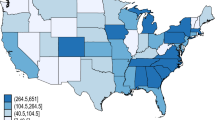Abstract
This paper examines the optimal fine for violations of environmental regulations, taking into account financial constraints facing regulated firms and the hierarchical structure of regulatory enforcement. Contrary to the existing literature, which suggests that maximal fines are sub-optimal, we find that the optimal fine is either the maximum amount the firm can afford to pay or zero (i.e., no regulation). The impact of a change in industry structure on the optimal fine, firm compliance and regulatory resource strategies is considered. We identify conditions under which the equilibrium level of regulatory resources decreases with an increase in the number of firms in the industry.
Similar content being viewed by others
References
Arbuckle, J. Gordon. 1993. “Water Pollution Control.” In Environmental Law Handbook, Twelfth Edition, edited by Government Institutes Staff. Rockvill, MD: 151–220.
Becker, Gary S. 1968. “Crime and Punishment: An Economic Approach.” Journal of Political Economy 76: 169–217.
Bose, Pinaki 1995. “Regulatory Errors, Optimal Fines and the Level of Compliance.” Journal of Public Economics 56: 475–484.
Chua, Dale H., Peter W. Kennedy, and Benoit Laplante. 1992. “Industry Structure and Compliance with Environmental Standards.” Economics Letters 40: 241–246.
Cohen, Mark A. 1992. “Criminal Law, Environmental Crime and Punishment: Legal/Economic Theory and Empirical Evidence on Enforcement of Federal Environmental Statutes.” The Journal of Criminal Law and Criminology 82: 1054–1108.
Cremer, H., M. Marchand, P. Pestieau. 1990. “Evading, Auditing, and Taxing.” Journal of Public Economics 43: 67–92.
Cushman, John H. Jr. 1995. “Senate Backs Cuts in Environmental Spending.” New York Times 15 December, sec. A, p. 35.
DiMento, J. F. 1986. Environmental Law and American Business. New York: Plenum Press.
Garvie, Devon and Andrew Keeler. 1994. “Incomplete Enforcement with Endogenous Regulatory Choice.” Journal of Public Economics 55: 141–162.
Hawkins, K. 1984. Environment and Enforcement: Regulation and the Social Definition of Pollution. Oxford: Clarendon Press.
Lepkowski, Wil. 1995. “Delegating Authority: Government Seeks New Balance in Environmental Protection.” Chemical & Engineering News 73(44):44–49.
Malik, Arun S. 1990. “Avoidance, Screening and Optimum Enforcement.” Rand Journal of Economics 21(3): 341–353.
Malik, Arun S. 1992. “Enforcement Costs and the Choice of Policy Instruments for Controlling Pollution.” Economic Inquiry 30: 714–721.
Melnick, R. S. 1983. Regulation and the Courts: The Case of the Clean Air Act. Washington, DC: Brookings Institutions.
Polinsky, A. Mitchell and Steven Shavell. 1979. “The Optimal Tradeoff between the Probability and Magnitude of Fines.” American Economic Review 69: 880–891.
Polinsky, A. Mitchell and Steven Shavell. 1991. “A Note on Optimal Fines When Wealth Varies Among Individuals.” American Economic Review 81: 618–621.
Portney, Paul R. 1990. “Evolution of Federal Regulation.” Public Policies for Environmental Protection, edited by Paul R. Portney. Washington, DC: Resources for the Future: 7–25.
Russell, Clifford S., Winston Harrington, and W.J. Vaughan. 1986. Enforcing Pollution Control Laws. Washington, DC: Resources for the Future.
Rutledge, G. L. and C. R. Vogan. 1995. “Pollution Abatement and Control Expenditures, 1993.” Survey of Current Business 75: 36–45.
Sanchez, Isabel and Joel Sobel. 1993. “Hierarchical Design and Enforcement of Income Tax Policies.” Journal of Public Economics 50: 345–369.
Stigler, George J. 1970. “The Optimum Enforcement of Laws.” Journal of Political Economy 78: 526–536.
U. S. Environmental Protection Agency. 1984. “Policy on Civil Penalties.” EPA General Enforcement Policy #GM-21. Washington, DC: U.S. Environmental Protection Agency.
U. S. Environmental Protection Agency. 1996. Enforcement and Compliance Assurance Accomplishments Report FY 1995. Washington, DC: U.S. Environmental Protection Agency, Office of Enforcement and Compliance Assurance.
U.S. Environmental Protection Agency. 1997. “Environmental Enforcement Sends Lawbreakers to Jail: Yields Millions for Local Environmental Improvements.” EPA Press Office, Region 1, Release #97–2–12. Boston: Regional Administrator's Office.
Viscusi, W. Kip, John M. Vernon, and Joseph E. Harrington, Jr. 1995. Economics of Regulation and Antitrust. Boston: MIT Press: 740–747.
Yeager, P. C. 1991. The Limits of Law: The Public Regulation of Private Pollution. New York: Cambridge University Press.
Author information
Authors and Affiliations
Rights and permissions
About this article
Cite this article
Lear, K.K., Maxwell, J.W. The Impact of Industry Structure and Penalty Policies on Incentives for Compliance and Regulatory Enforcement. Journal of Regulatory Economics 14, 127–148 (1998). https://doi.org/10.1023/A:1008005201435
Issue Date:
DOI: https://doi.org/10.1023/A:1008005201435




